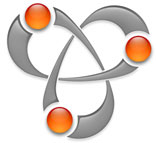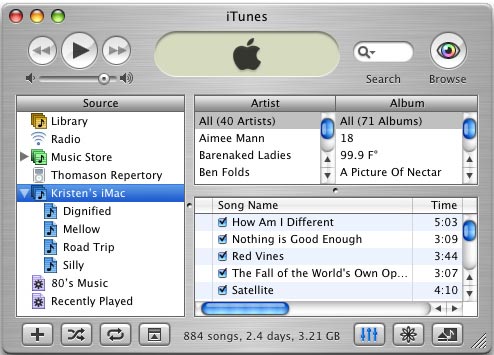



 Apple’s Rendezvous networking technology is often mistaken for a music
sharing service or other familiar application. The Pi’s TCS Web site
is a good place to go for clarification. When the iTunes 4.0.1 update narrowed
the music sharing features of 4.0, one TCS participant blasted Apple for
allegedly killing Rendezvous. Jon Thomason attempted to set the record straight
with the following message, nominated among the “Best of the TCS.”
Apple’s Rendezvous networking technology is often mistaken for a music
sharing service or other familiar application. The Pi’s TCS Web site
is a good place to go for clarification. When the iTunes 4.0.1 update narrowed
the music sharing features of 4.0, one TCS participant blasted Apple for
allegedly killing Rendezvous. Jon Thomason attempted to set the record straight
with the following message, nominated among the “Best of the TCS.”
Rendezvous is Apple’s brand name for a series of technologies they helped develop as part of the Internet Engineering Task Force’s Zeroconf (zero configuration networking) working group. Together, their goal is to bring the famed simplicity of AppleTalk to plug-and-play ad-hoc TCP/IP networking. Individual parts of the suite facilitate assigning IP addresses, giving them human-readable names, advertising and discovering the services they provide, and a bit more that isn’t much used as yet.
This is all about networking on a local, unmanaged network. It’s for home users or small businesses without their own IT staff running a DNS server or even DHCP. People who would otherwise have to remember and hand-type “192.168.0.…” whenever they want to do anything like share files or printers.

For more information about Rendezvous and the companies and products which
support it, visit Apple's web site
http://www.apple.com/macosx/jaguar/rendezvous.html
Anything that travels across the Internet is, by definition, not Rendezvous. The Internet already has that stuff covered by squadrons of trained professionals.
Apple announced their support for this movement a year ago, to a roomful of software and hardware developers attending their Worldwide Developers Conference in May, 2002. It was abundantly clear within the building that those assembled understood the implications: specifically that (with help from those present and the companies who sent them) we’ll start seeing home networking become vastly easier in a fairly short order.
As developers embrace Rendezvous in their products, home gateway devices will become far easier to set up and will provide more services. Network-savvy printers can be built to communicate TCP/IP without any of the arcane setup that this has traditionally entailed. More interestingly, Rendezvous will pave the way for devices you wouldn’t expect to be networked, to become networked. Wireless video cameras, PDAs, TV, stereo…
Of course, network infrastructure demos are always rather dry. To be certain they would seize developers’ imaginations, Apple was compelled to demonstrate a little extra flash and pizazz.
So in traditional demo gimmick fashion, Apple tweaked a version of iTunes to be able to serve out its music list and share it with another copy of iTunes on the local network. And to the dismay of developers, many rumor sites took this one gimmick to be the entire promise and purpose of Rendezvous. (By logical extension, it might as well be said to be the promise and purpose of TCP/IP networking in general. We’ve of course seen file transfers before; what’s new here is the way these two machines noticed each other and started talking without the need for some trained professional to have hand-configured a special server somewhere.)
The presenters stated up front that this was a gimmick. A “technology demonstration” meant only to show that Rendezvous is the kind of thing that can inspire clever developers to enable entire new worlds of networkability and sharing. Their more “on-message” demos involved real live printers and routers and video cameras. But like any other foundation network technology, it will take a while to get that support into products out in the field.
OK—so flash-forward a full year. Mac OS X “Jaguar” is released to the public. Rendezvous has established itself for USB printer sharing, and for connecting to file servers: It’s finally managed to successfully replace the Chooser. Linksys hasn’t yet released their friendly home routers, but TiVo has jumped into a role embracing the iLife suite. A broad range of new ShareWare gizmos now share bookmarks, desktops, whiteboards, calendars… all sorts of things between local machines. And articles on the O’Reilly Network encourage pairing Rendezvous with the Apache Web server to facilitate informal intranet Web development.
Lastly, Apple has a new version of iTunes in the wings. Its primary feature is a new way to purchase downloadable content, but it also includes the feature they’d teased us with a year earlier: the ability to stream music between two Macs running iTunes. All copies of iTunes within a household network are put in touch with each other automatically, thanks to Rendezvous.
Now—it’s important that you follow me here. The 4.0 version would talk to anyone who contacted it. If you set up your iMac in a fixed location on the Internet, ran a copy of iTunes 4.0, and told everybody where to find that machine, then up to five people at a time could contact it and browse through the music in your collection.
This… Was… NOT… Rendezvous.

iTunes 4.0 adds the Music Store plus any locally networked machines to its list of available music sources.
Rendezvous is the behind-the-scenes part that iTunes uses to automatically discover other copies of iTunes running on your local network. When your daughter opens her iBook, her music library appears next to Internet Radio as one more available source of content. This demonstrates the announcement and discovery of available services, which is one facet of Rendezvous.
All actual communication that takes place after the machines have found each other—the music sharing service being discovered—is a proprietary thing Apple created just for iTunes. It works over TCP/IP, and does not involve Rendezvous.
So when you post your IP address in a chat room and tell people that you’ve collected there all the known works of Frank Zappa, that’s not Rendezvous. That’s just you mouthing off in a chat room. Do you follow me, so far?
Step a bit further: the open source community notices that the new protocol is nicely organized and fairly understandable. I have to say I did some of this myself: I’ve been playing with a few home jukebox ideas of my own for a while.
But then people started producing tools that would not just stream music but easily browse, select, transfer, and save songs to disk as pristine copies.
While at the same time, new Web sites were presenting themselves with broad search engines designed to put interested collectors in touch with your Zappa collection.
This, once again, is separate from Rendezvous: Rendezvous would put your home Macs in touch with each other, but outside your home requires something like these Web sites to announce your collection to the world.
In other words, people were building a new ad-hoc Napster in two parts, both centered around iTunes. Apple needed to step out of the middle of this before it truly became dangerous to their music initiatives.
So what did Apple do in iTunes 4.0.1?
They went back to the original “technology demonstration” and made it just so: iTunes will only communicate with other copies of iTunes on your local network. Just as originally demonstrated a year ago, and just as described in public ever since. It will no longer export your music into off-site collection pools. You’ll just have to go back to using non-Apple software to do that for you.
The change had nothing to do with Rendezvous, except in that it reemphasized the home networking piece of the puzzle. And it didn’t back away from any of the features that everyone has anticipated even after that popularly misconstrued demo of a year ago.
Well, that’s my sermon. In this globally networked world I feel it’s important to recognize that “sharing” and “networking” are not synonymous terms.
Jon is a software developer and network administrator, and is one of many regular contributors to the Pi’s TCS discussion boards.